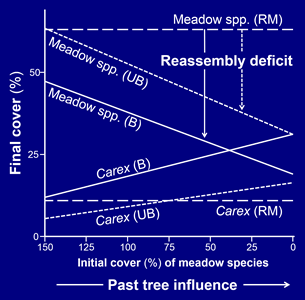| Cover of meadow species increased after tree removal, but to a lesser degree in burned than in unburned subplots (figure right, upper panel). Conversely, Carex increased to a greater degree in burned than in unburned subplots (lower panel), emerging from a well-developed seed bank. Cover often greatly exceeded that found in reference meadow transects (dashed lines).
Over time, the nature of the association between meadow species and Carex changed. Before treatment (2004), meadow species and Carex were positively correlated in experimental plots (table, below), reflecting their similar negative responses to tree encroachment. However, at final sampling, correlations ranged from weakly negative among unburned subplots to strongly negative among burned subplots. In reference meadows, for comparison, the correlation was moderately negative.
| Correlations between meadow species and Carex cover |
|
2004 |
2013 |
Unburned |
r = +0.30, P = 0.001 |
r = –0.14, P = 0.080 |
Burned |
r = +0.50, P < 0.001 |
r = –0.60, P < 0.001 |
Reference meadow (RM) |
r = –0.30, P < 0.001 |
|
Preemption by meadow species and Carex was reciprocal, offset in time and space, and mediated by fire. In different sets of subplots we observed either preemption of Carex by meadow species or preemption of meadow species by Carex (see partial correlations in table, below).
Over time, the effect of meadow species on Carex switched from neutral or positive (legacies of their pre-treatment association) to negative, and increasingly so in the burned treatment. The effect of Carex on meadow species was slower to develop. It switched from neutral or weakly positive to increasingly negative. Burning both accelerated and enhanced this effect.
| Evidence of preemption by meadow species and Carex |
| |
Effect of Meadow
on Carex |
Effect of Carex
on Meadow |
| Year (t) |
Unburned |
Burned |
Unburned |
Burned |
|
| 2007 |
ns |
+0.40 |
+0.08 |
ns |
| 2009 |
-0.23 |
-0.29 |
ns |
-0.12 |
| 2013 |
-0.19 |
-0.50 |
-0.21 |
-0.32 |
|
| Partial correlation coefficients represent effects of cover at the previous measurement (t-1) on cover at the current measurement (t) for the reciprocal interactions between Carex and meadow species. Year = current measurement; ns = non-significant. |
|
|
Tree removal and fire imposed over a mosaic of altered states—reflecting varying degrees of tree influence—produced a range of reassembly outcomes (figure, right). In areas of limited or only recent tree influence (high initial cover of meadow species), surviving meadow species inhibited Carex, irrespective of fire. In contrast, in areas of greater tree influence (low initial cover of meadow species), Carex inhibited meadow species, but only with burning.
Fire had both direct and indirect effects, contributing to variation in the "reassembly deficit". It had a strong direct effect, reducing meadow cover and richness across the gradient of past tree influence. However, it also had an indirect negative effect, mediated by the expansion of Carex in areas of greater tree influence.
Conclusions
Tree removal and fire led to substantial variation in community reassembly across the gradient of encroachment states. Counter to conventional wisdom, fire tended to destabilize the remnant meadow community and, in areas of greater tree influence, it stimulated release of Carex, inhibiting subsequent reassembly. Knowledge of the context dependence of these effects (or interactions) can enhance the effectiveness of restoration by identifying the conditions under which particular treatments produce desired outcomes.
Halpern, C. B., J. A. Antos, D. McKenzie, and A. M. Olson. 2016. Past tree influence and prescribed fire mediate biotic interactions and community reassembly in a grassland-restoration experiment. Journal of Applied Ecology 53:264-273. doi: 10.1111/1365-2664.12570  Request reprint Request reprint |
|
| Changes in cover of meadow species and Carex |
| Meadow species |
 |
| Carex |
 |
| Frequency distributions of cover of meadow species and Carex among subplots representing each treatment, before tree removal (2004) and at final sampling (2013). Vertical lines are medians of treatments (solid, n = 160) and reference meadows (dashed, n = 117). |
|
|

| Reassembly deficit |
 |
| Meadow species and Carex cover at final sampling (2013) as a function of past tree influence (initial cover of meadow species, 2004) and treatment. Vertical arrows represent the ʽreassembly deficitʼ, i.e., difference in meadow cover between experimental subplots and reference meadow. Sloping lines are fitted relationships (B = burned, solid; UB unburned, dotted) (n = 160 subplots). Horizontal lines (RM, dashed) are Rreference meadow medians. |
|
|
|
![]()
![]()
![]()
![]()


